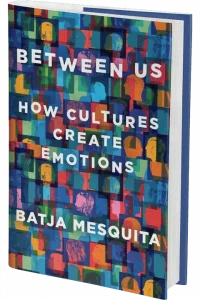
I am not exaggerating when I say that this book blew my mind! I will never look at emotions, and the impact of culture, the same way again. If you work in any cross-cultural setting, this book is essential reading. This book opened my eyes to how much of my understanding about emotions is influenced by my WEIRD cultural background; from the way I define the concept of an emotion. to specific emotions that I recognise. and how people behave when experiencing them.
The author introduces two models of emotions – the MINE model (which is the one most people from a WEIRD background experience; and the OURS model, which is globally more common. She distinguishes between a concept of emotion that is something felt internally, and an emotion as something that takes place between people.
The MINE model thinks of emotions as mental, and that feelings are important. They are experienced as if they are inside us, the emphasis is on what is going on inside the individual, and they are expressed from the inside-out, our internal emotions seek expression. In contrast, the OURS model things of emotions as outside of us – the focus is on what is going on socially, and they are relational – acts are important. Finally, emotions in this model are situated outwards-in. Emotional acts seek to meet social norms, and suppression of emotions helps to cultivate the appropriate feeling.
What she explains in the book is much more than a technique to ‘translate’ emotions that we recognise into emotions that others might recognise. Rather, it’s a challenge to the whole way we think about and experience emotion. The author discusses recent emotions researchers such as Lisa Feldman Barrett, and she also demonstrates how many of their research and findings are filtered through a MINE model of emotions.
She specifically covers MINE emotions such as anger, shame, happiness and love, and explores how these emotions simply do not make sense in an OURS model. She also introduces OURS emotions such as amae, gezellig, and fago.
She introduces a very practical toolkit that we can use to unpack emotional episodes. The kinds of questions she suggests are not just useful to understand cross-cultural differences, but also individual differences between people from the same cultural background.
There is so much of value in this book, I am finding it hard to provide you with a brief overview. In summary, this is one of the most profoundly impactful books that I have read. I can’t recommend it highly enough.

